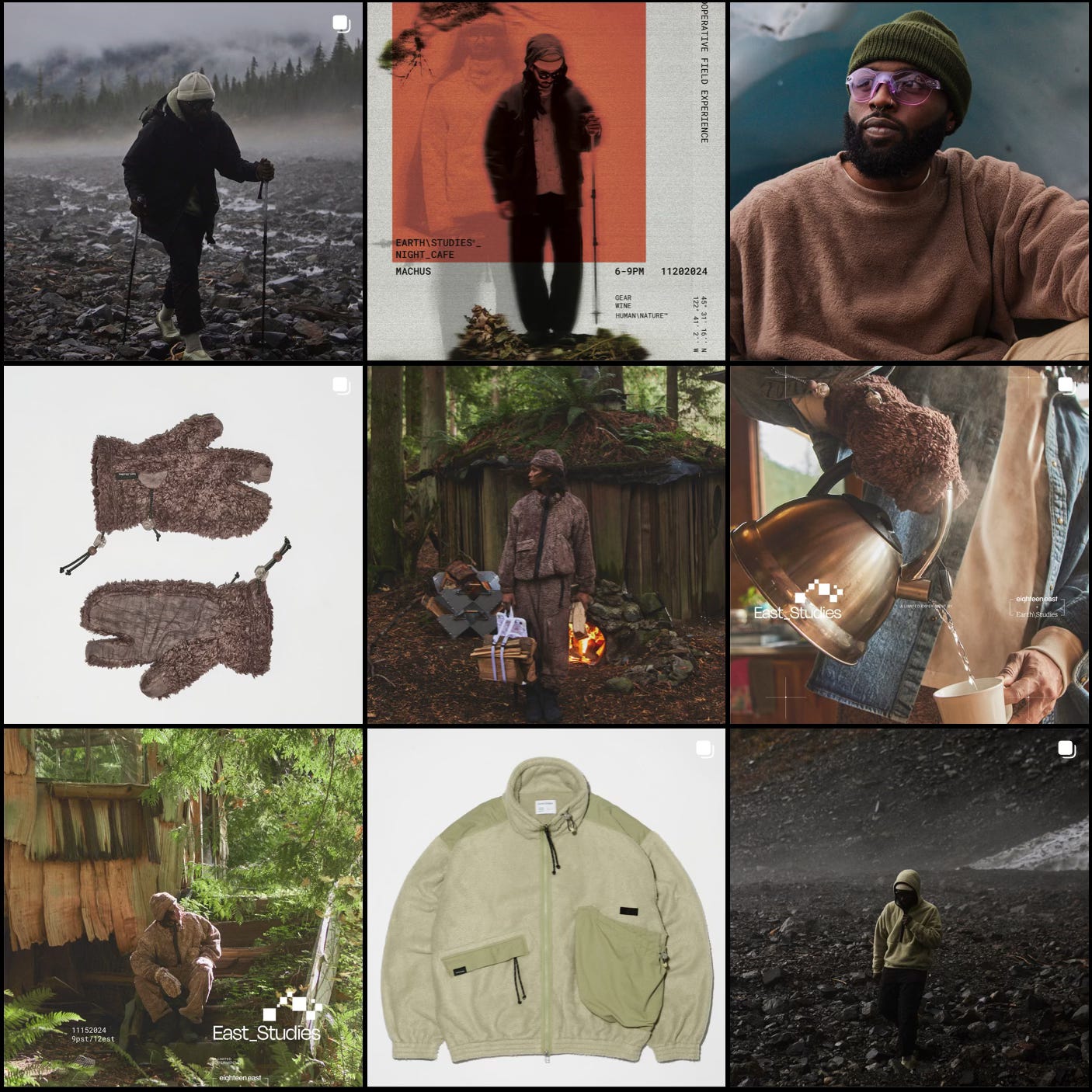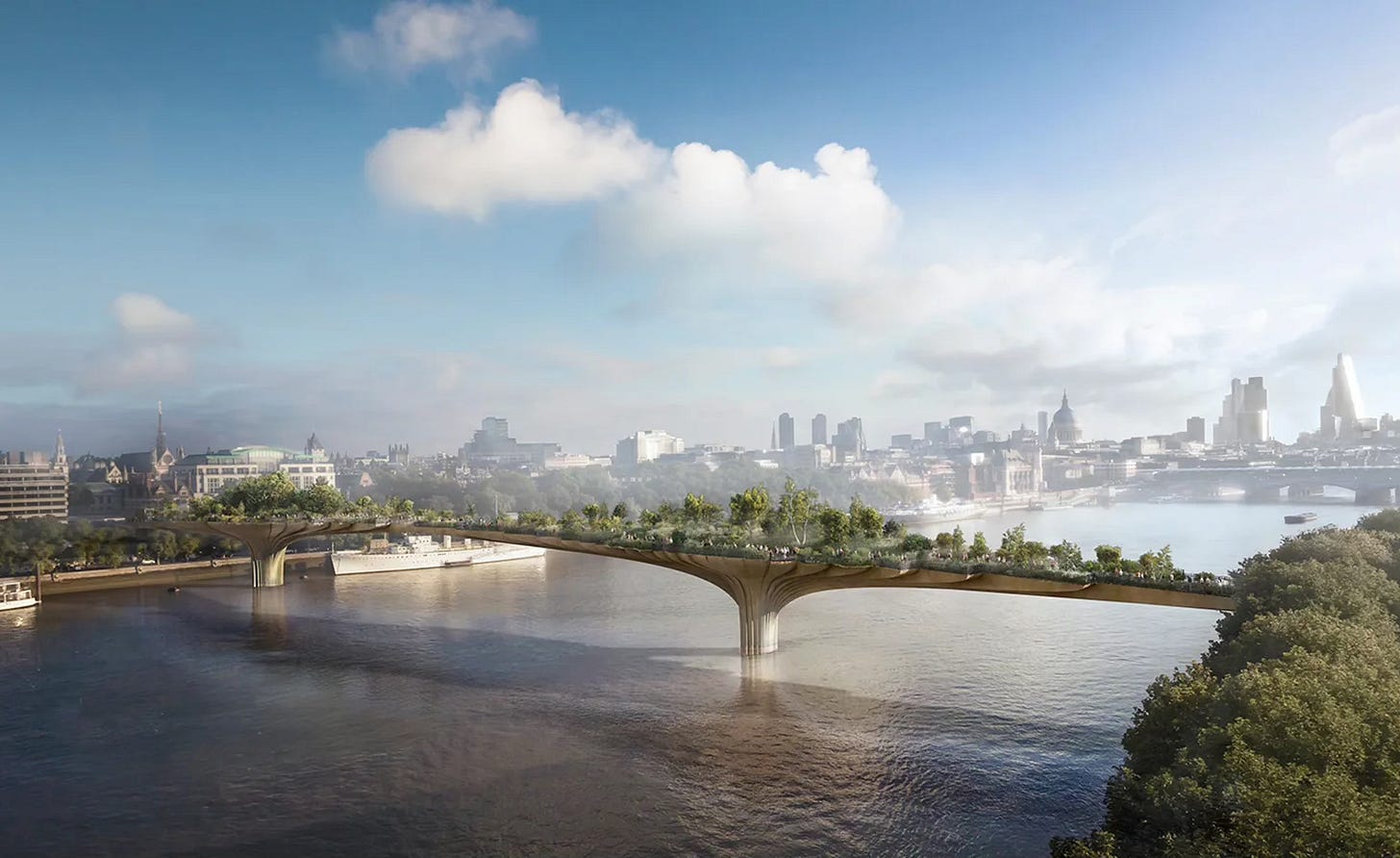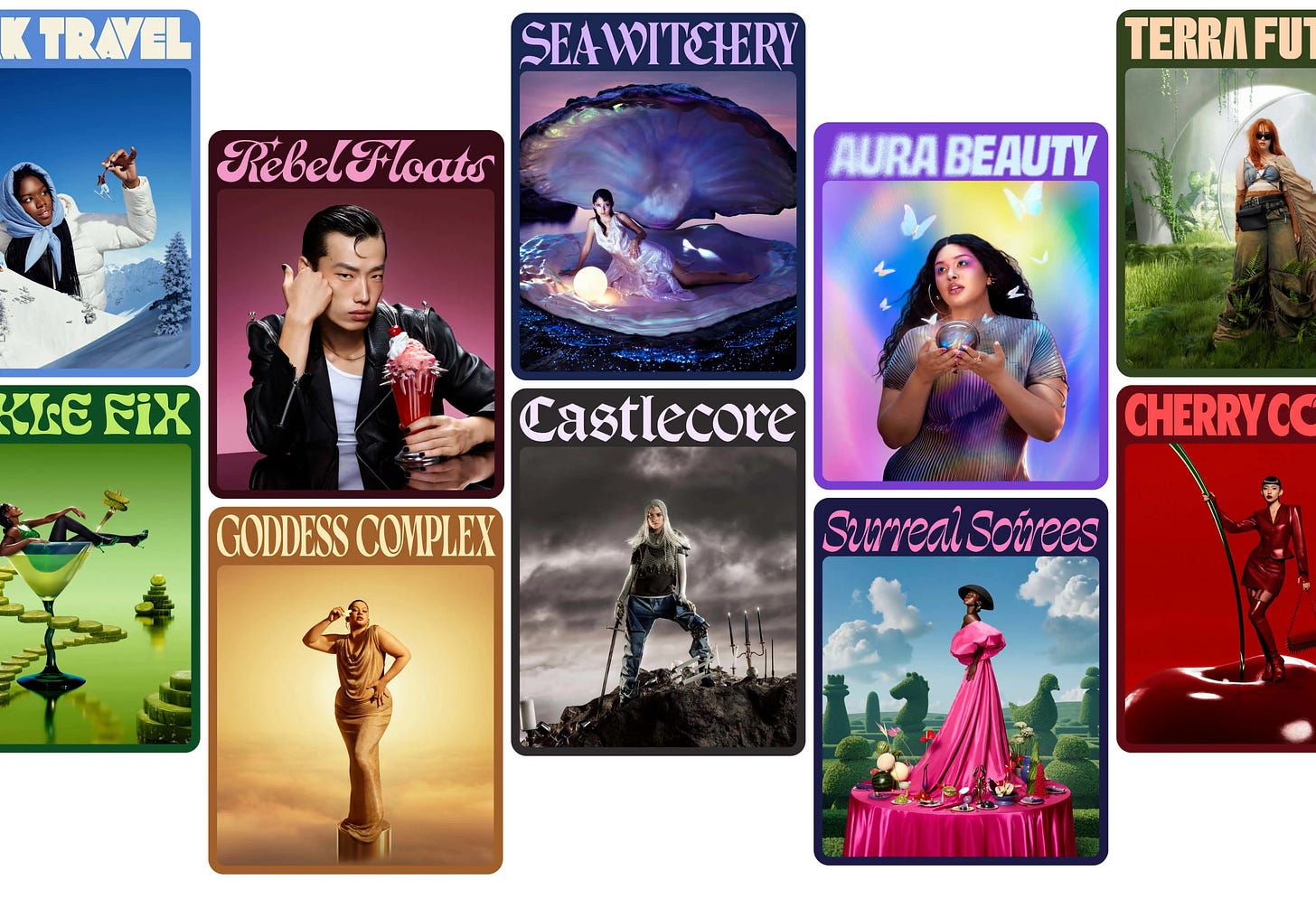Dissecting Pinterest's Terra Futura "trend"
Solarpunk, gorpcore and biophilic aesthetics.
Welcome to Mutant Futures: a newsletter about culture, futurism and strategy.
In this edition, I’m discussing aesthetic production and consumption on Pinterest, and how moodboards can influence our perception of sustainability.
Let’s get into it 🔬
About a month ago, Pinterest released their Pinterest Predicts 2025 report, a selection of trends and aesthetics they think will take off in the new year. Among the very fashion- and makeup-focussed looks, like ‘Cherry Coded,’ ‘Rococo Revival,’ and ‘Sea Witchery,’ I noticed a bit of an outlier: ‘Terra Futura.’ The description for that read as follows:
Meet the rebels with a cause. In 2025, Boomers and Gen X will lean into sustainable living with recyclable fashion, self-sufficient gardens and community spaces. The best part? This eco-living aesthetic will bring some stellar sci-fi vibes along with the seriously cool real-world wins.
This had me scratching my head in all kinds of ways: being green is rebellious now? No Millennials, no Gen Z? Are they suggesting sustainability is a fad for 2025 only?
Intrigued yet confused, I did some digging on how Pinterest actually identifies these ‘trends’. Here’s the methodology in a nutshell:
Data crunching: they analyse billions of monthly Pinterest searches, tracking patterns and fast-growing topics from all over the world.
Connecting the dots: they engage researchers, designers and strategists to pull everything together, extracting cohesive themes from the noise.
Reality check: they choose trends that are relevant, inclusive and actually reflect the lives people are living, or want to live.
Oh you like our crystal ball? 🤑 (Pinterest rubs hands) 🤑
Before we dive into my head-scratches, a note on the strategy driving Pinterest Predicts. Since 2019, Pinterest has expanded its business as a moodboarding platform serving ads, to a cultural oracle that brands can consult for their creative direction and marketing.
By positioning itself as a trend authority with detailed receipts (user insights from first-hand data), they’ve opened up a whole new revenue stream. In an age of neverending virality, where brands are obsessed with jumping on trends to gain cultural relevance, Pinterest’s crystal ball is tempting to stare into.
And while the target audience of Predicts is brands, the predictions are sure to resonate with users too. It has 537 million active monthly users (as of Q3 2024). The platform has become the tool for creatively directing our lives. But also, what we pin is shaped by what the algorithm shows us. Users who algorithmically discover curated aesthetics like Terra Futura may be inspired to update their wardrobe, interior, or even lifestyle if they like what they see. Inspiration and imagination come before action.
Zooming in on the Terra Futura aesthetic, today’s discussion is about how moodboard aesthetics can shape consumer behaviour. Because one of this Substack’s curiosities is how we can shift culture into a greener gear. Is it possible to fast-track a consumer shift towards more sustainable values, by linking it to an aesthetic?
Let’s explore that.
Terra Futura = gorpcore meets solarpunk
The official Pinterest board for Terra Futura features a diverse selection of pins:
Gorpcore outfits and lookbook photography
Otherworldly landscapes
Futuristic architecture
Geometric plant close-ups
Visually tasteful gardening
Shrubby. Mossy. Often green. And very science fiction-coded overall.
Some of the pins link to articles like ‘What is chaos gardening and should we all be trying it?’ (I had no idea what that is, so I did click on that. Here’s my explanation with a cooking analogy: you know when you’re making a stir-fry and you’re adding ‘a little bit of this’, ‘a little bit of that’ to the mix, and somehow it just works? Chaos gardening is like that, but for plants. It’s about letting things grow, without stressing about placement or arrangement. So rebellious 🤨 Anyway—back to the moodboard!)
Then aside from the gardening how-to’s, some of the pins link to articles on the art and architecture showcased in the board. There’s a fixation with a snake-like condo in Mexico, and one pin even takes you to its AirBnB listing.
It’s interesting how Pinterest conceptualised this vision, when you consider the trending search terms it singled out for that:
solarpunk house
self sufficient garden
solarpunk fashion
community spaces
chaos gardening
The answer lies in the word ‘solarpunk’.
At its core, solarpunk is about imagining a future where sustainability, community and nature are embedded in society. It represents a hopeful alternative to the dystopian depictions we see in sci-fi genres like cyberpunk. The ‘solar-’ part references solar power and a future powered by renewable energy. And I’ll come on to the ‘punk’ part shortly.
Plants and biophilic design (which fuses architecture with nature for example), are key to imagining a solarpunk world. Nature doesn’t just decorate spaces, but collaborates with them. I made a little Pinterest board of my own, for solarpunk:
The world of Terra Futura is evidently less idyllic and shrubby, and focuses more on vibes than visions of the future. It could alternatively be labelled ‘Earthcore’.
In any case, could this sort of moodboard worldbuilding nudge us towards more sustainable thinking?
➡️ Not so sunny: a gateway to consumption
Maybe not through a moodboard, or Pinterest in general. You might stumble upon chaos gardening tutorials if you’re browsing biophilic architecture for example. Or maybe some solarpunk pins sent you down a rabbite hole of DIY renewable energy hacks for the home. But as mentioned earlier, Pinterest’s endgame is to get you buying things. They create worlds, then weave product placement into them. They even did a ‘trend drop’ to give away a home accessory with a Terra Futura look. Ironically, searching ‘solarpunk fashion’ will give you pins accompanied by ads for Shein and Amazon clothing. This takes a dump on the solarpunk ethos (the ‘punk’ part of the name), which is firmly anti-consumerist.
➡️ Also not so sunny: a quick greenwash for brands
For brands looking to use Terra Futura or solarpunk for their creative direction, they’d need to consider the optics of that. Projecting a futuristic image is an empty promise if their business practices don’t back that up. Without sustainable production methods, ethical sourcing, and other environmental commitments, this could be viewed as greenwashing. Given how sticky climate disasters are getting around the globe (I’m looking at you LA 😢), brands should not act like the dog in this meme. So simply leaning into solarpunk purely for its aesthetics could be viewed as performative virtue signalling.
Biophilia hypothesis - nature is wifey
To round off today’s post, let’s talk about how nature influences culture. Do earthy aesthetics, like those used by outdoor brands, encourage a closer connection to nature? And does that shape our environmental values?

There’s plenty of research suggesting that we’re programmed to be attracted to nature. The idea dates back to the biophilia hypothesis introduced by Edward O. Wilson in Biophilia (1984). In his book, the biologist proposed that humans are genetically programmed to connect with nature—and rely on it for their wellbeing. It’s why photos of plants evoke a sense of calm and grounding for example. It’s also why biophilic design is used to enhance wellbeing and efficiency in modern architecture.
We all use plants to enhance our homes, whether it’s through gardens, house plants, a lil cactus or even just a fake plant. But that’s the thing—we don’t all have the same exposure to nature. Beyond that, we escape to it when running in the park or hiking out of town, but otherwise it’s a scarce commodity.

For those who lived in London in the 2010s, we got a glimpse of a more biophilic city with the Garden Bridge proposal. In his days as mayor (before we realised how trash he was), Boris Johnson tried to make this a reality. The idea was to have a bridge over the Thames filled with trees, shrubs and plants, creating a green oasis amongst the concrete, metal and glass. Sadly it never came to be, cause the project was scrapped for financial reasons.
For now, we can only daydream about our cities looking like Wakanda. Terra Futura caught my attention because it a romantices a life where plants and plant-adjacent things are everywhere. And while it is just another product of Pinterest’s commercial machine, it’s also food for greener thought and inspiration.
Hiking into the future
By taking gorpcore world-building to the next level, Terra Futura elevates nature and an outdoor-centric life to something aspirational. Maybe you’re tired of the party life and ready for your hiking era (Gen Z is doing just that). This is where the spirit of solarpunk comes in: the more you immerse yourself in a wholesome community, the more wholesome you become. After picking up some hiking gear, you might discover new brands that prioritise sustainable materials. This might get you researching how to make your gear last longer. You might get tips from other hikers or even second hand deals—and so on. Suddenly you’re embracing a more sustainable, circular approach to all your clothing.
Of course, some of us just want to look cute on a mountain peak for Instagram. But for others, subcultures linked to nature are the first step towards a slower, more intentional life. By immersing ourselves in new communities, we acquire new values. And hopefully those values lead to positive impact. In 2025, and beyond.
If you read to the end of this post, you’re a real one! 💜 If you haven’t subbed already…






